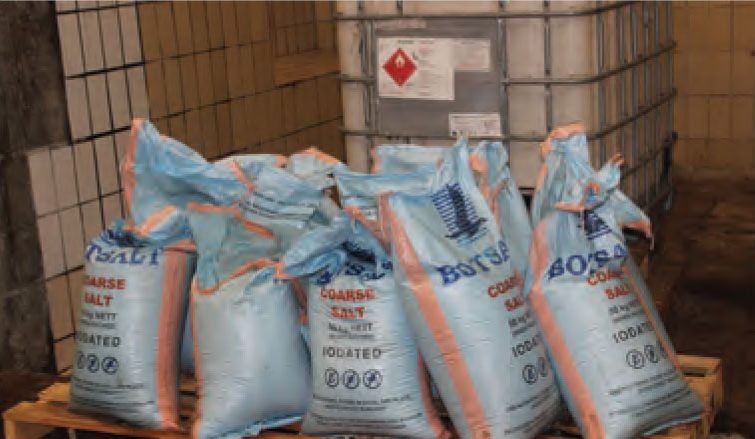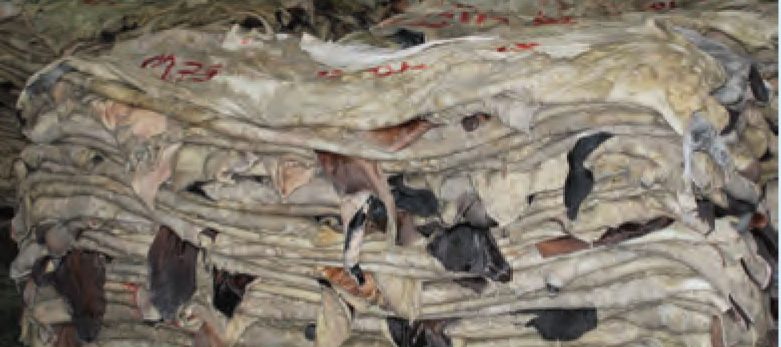
In 2017 the BMC Tannery processed a total of 88 532 hides. All these hides were drum salted. The number of hides processed is directly proportion-al to the number of cattle slaughtered at BMC Lobatse. The Tannery does not process hides from either BMC Maun or BMC Francistown or from private entities. Hides from Maun and Francistown are processed at their respective areas and tannery/salting services are outsourced. Once the hides arrive at the BMC Tannery they get salted using mechanically operated drums.
The drums are preferred to manual or convention-al method of salting for the below reasons;It is faster to use drums for processing as the hides are palletized immediately after processing whereas with manual salting hides are spread on the floor and sprinkled with salt and left in the stacks for a minimum period of 14 days before the stacks can be broken and palletizing done. This takes a lot of space and time taking into consideration the number of hides handle every day. To save space a big stack is normally made and some hides end up spending more than 14 days in the stack.
This may lead to excessive moisture loss and subsequent excessive drying.Chemicals used for Drum salting are calculated based on the weight of the hides leading to proper curing, whereas with manual salting the amount of salt used is determined visually which may lead to over dosage or the dosage being too little. A high dosage of salt leads to most of it being undissolved and some of it going to waste. It is also costly as more salt would be used.

A combination of chemicals particularly preserva-tion antiseptics (which are liquid) can be used together with salt in Drum preservation whereas with manual salting only salt and Boric acid (granu-lar) are used and thus compromising the quality of the hides.
The BMC Tannery therefore strive to have its drums in good running order so as to avoid manual salting.
PROCESSING
COARSE SALT
Coarse salt is used during Drum processing. Salt itself does not kill Bacteria but rather renders it Dormant or inactive for the period in which conditions would not favour it to be active and multiply. Coarse salt is preferred over fine salt because it dissolves slowly and then penetrates the Hides to extract water by Osmotic action. The salt then replaces the water and crystalizes inside the hide rendering conditions unfavourable for bacteria to be active. Pan salt is preferred over Sea salt since it is cleaner and has minimal Halophilic (salt loving) bacteria. Studies have shown that Halophilic
bacteria is marine based and hence the need to avoid sea salt where practically possible. Salt is a long term preservative and every care should be taken to ensure that processed hides are stored properly to avoid heat and water which would make
bacteria active and lead to putrefaction (rotting) of hides.

BACTERICIDE (LIQUID)
Since salt is not poisonous to bacteria, there is a liquid bactericide which is used to compliment the effectiveness of salt during preservation. This bactericide is toxic and is used in very minimal quantities since it has a mild tanning effect on hides meaning that it would hamper proper Tanning during the subsequent processes of Leather Manufacture. The Bactericide being referred to is a short term preservative and is intended for the initial stages of preservation when hides are still vulnerable to Bacterial degradation.
BORIC ACID (GRANULAR)
During salting there is a bacteria called Halophilic or salt loving Bacteria. This bacteria thrives in the presence of salt and every care should be taken to make sure that it does not find its way into the hides.
It is therefore paramount that Boric acid is used to prevent Halophilic bacteria. Hides with this bacteria can be identified by purplish to red spots referred to as RED HEAT. Boric acid is used in minimal quantities.
All the above mentioned Chemicals are added simultaneously to the hides. Their quantities are calculated based on the weights of the hides. The Processing drums are then run for 3 Hours after which the hides are offloaded and palletized. Hides are palletized according to their different weight ranges of: Extra Lights, Lights, Mediums, Heavies and Extra Heavies. Hides of these five (5) classifications are palletized separately. They are then labelled and stored. Before dispatch salted hides are sprayed with 4% Soda Solution. This is to guard against any Foot and Mouth Virus.
Drum salted hides are stored for a minimum period of 14 days before dispatch. This is to allow for drainage of excess water and to avoid disturbing the curing process. The hides are sold based on weight and hence the need to allow excess water to drain out.
The hides are currently being sold to South Africa. Market demands are difficult to satisfy owing to the inconsistent number of cattle being slaughtered at our abattoir. These hides are sold to the highest bidder and the tender is awarded after a tendering processes which is presided over by the BMC Management Tender Committee. Salted hides are processed further into LEATHER and the final products are dependent on the operations of the buyer. These may range from Bags, shoes, automotive, upholstery etC.
The challenges encountered by the BMC Tannery in 2017 were:
a) Inconsistent and low supply of hides from our abattoir
b) Machine breakdowns.
The plan for BMC Tannery in 2018 is to continue processing hides of the highest quality, which meet customer specifications and exporting them timeously.
The BMC Tannery contrary to the name is actually a salting facility. Tanning is a process of turning hides into Leather but here we are just preserving hides and selling them in that state. We discontinued Tanning in 2006 due to environmental issues. Before ceasing our Tanning Processes in 2006 we were tanning our hides up to a stage called WET BLUE. We were using Chrome powder to tan our hides but even then they were not a finished product and had to be processed further by whoever bought them before they could be used. At that time our main market was Italy.




